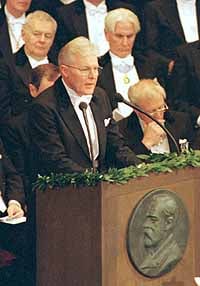Award ceremony speech
Presentation Speech by Professor Sten Lindahl of the Nobel Committee at the Karolinska Institutet, December 10, 1998.
Translation of the Swedish text.

Copyright © Nobel Media AB 1998
Photo: Hans Mehlin
Your Majesties, Your Royal Highness, Ladies and Gentlemen,
When Robert Furchgott, Louis Ignarro and Ferid Murad independently discovered that a short-lived gas, nitric oxide, NO, was endogenously produced and acted as a signaling molecule between cells – it was unexpected and unique. It initiated a new chapter in biomedical research and new horizons were anticipated.
It was Robert Furchgott who opened up the field in 1980. During the 1970s, researchers realized that the innermost cell layer of blood vessels, the endothelium, not only had passive, protective properties. Furchgott demonstrated, quite unexpectedly, that contraction and relaxation of blood vessels were dependent on whether the endothelium was present or not. In a brilliant experiment – the so called sandwich experiment – he made a key discovery which set the stage for future scientific developments. In his sandwich study, responses from different pieces of aorta were investigated. One piece had the endothelial layer intact, while in the other it was removed. In the absence of endothelium, he recorded a contraction at stimulation. The piece with endothelium was prepared so that neither contractions nor relaxations were possible. When he put the two pieces together in a sandwich model he found that the same stimulation no longer resulted in a contraction, it relaxed! Furchgott concluded that an unknown substance, a factor, was produced in the endothelium, was transported to the piece of aorta without endothelium and caused relaxation.
This was a great discovery. It became the starting-shot of a scientific hunt for the identity of the endothelial factor. A search that went on for six years. Different hypotheses were launched. One of them was that nitro-compounds were involved. It was within this field of research that Ferid Murad was active. He knew that nitroglycerine activated an enzyme in aortic muscle cells, guanylylcyclase, which increased cyclic GMP and caused relaxation. Ferid Murad now asked an important question. Did nitroglycerine act via release of nitric oxide, NO? He tested his hypothesis by simply allowing NO gas to bubble through a tissue preparation containing guanylylcyclase. The production of cGMP increased. A new mode of action for drugs to activate enzyme function was discovered. The working principle of nitroglycerine, up to this point unknown in spite of more than 100 years of successful treatment for angina, was now revealed. These experiments by Ferid Murad, performed a few years ahead of Furchgott’s discovery of the endothelial factor, created new knowledge which later became the “trail” for identification of the endothelial factor.
It was on this “trail” that the third Nobel Laureate in Physiology or Medicine of this year, Louis Ignarro, also had his scientific experience and activities. Inspired by Murad’s findings, he also reported that NO relaxed blood vessels. Simultaneously with, but independently from Robert Furchgott, he also added, during the first half of the 1980s, knowledge about the factor. Its identity was becoming clearer. The hunt for Furchgott’s endothelial factor came to an end during a scientific meeting at the Mayo Clinic, Rochester, Minnesota, USA in the summer of 1986. At the meeting Furchgott concluded, based on several findings, that the factor was identical with NO. Ignarro supported this at the same meeting. Ignarro also went one step further in an interesting experiment. He used spectral analysis, which means that each substance emits a specific, unique spectrum. He found identical spectra when reduced hemoglobin reacted with the endothelial factor and with NO, and concluded that the factor was NO.
The hunt was over. The riddle concerning the endothelial factor was finally solved. An endogenous short-lived gas, had the capacity to act as a signaling molecule between cells in the body. This was a new phenomenon. The discovery explained the mode of action for nitroglycerine when used to treat high blood pressure and angina, a disease that Alfred Nobel also suffered from. He wrote: “It sounds like the irony of fate that I have been prescribed nitroglycerine – internally. They have named it Trinitrin in order not to upset the pharmacists and the public.” Alfred Nobel knew that nitroglycerine could also cause headache. He did not follow his doctor’s orders. The discovery that the endothelial factor was nitric oxide also initiated new therapies in clinical medicine, improved diagnostic capabilities for serious inflammatory diseases, and opened up new possibilities for drug development. The continued research within the NO field from 1986 till today, has been enormous.
Professors Robert Furchgott, Louis Ignarro and Ferid Murad:
Your discoveries concerning nitric oxide as a signaling molecule in the cardiovascular system, have not only explained the working principle of an old important group of drugs, the nitrovasodilators, it has also opened new avenues for patient treatment and diagnoses of various diseases. Your discoveries have lifted medical research into a new era. On behalf of the Nobel Assembly at Karolinska Institutet, I wish to convey to you my warmest congratulations, and I now ask you to step forward to receive your Prize from the hands of His Majesty the King.
Nobel Prizes and laureates
Six prizes were awarded for achievements that have conferred the greatest benefit to humankind. The 14 laureates' work and discoveries range from quantum tunnelling to promoting democratic rights.
See them all presented here.
